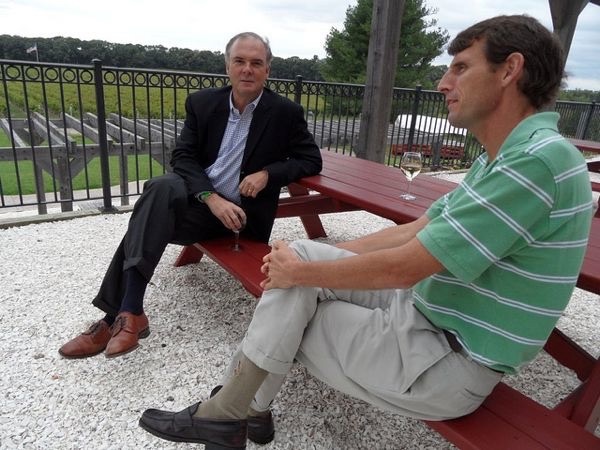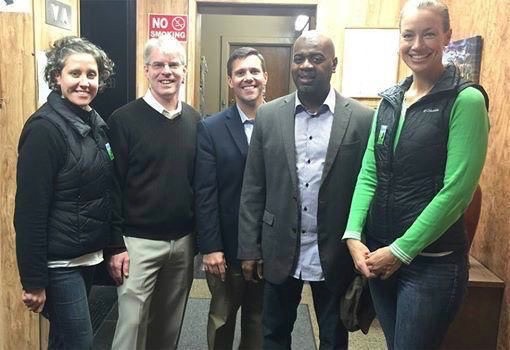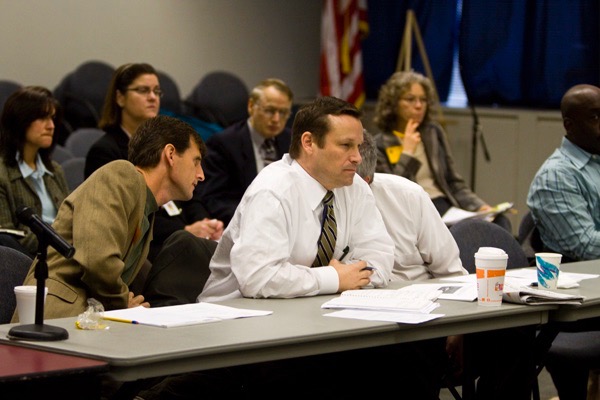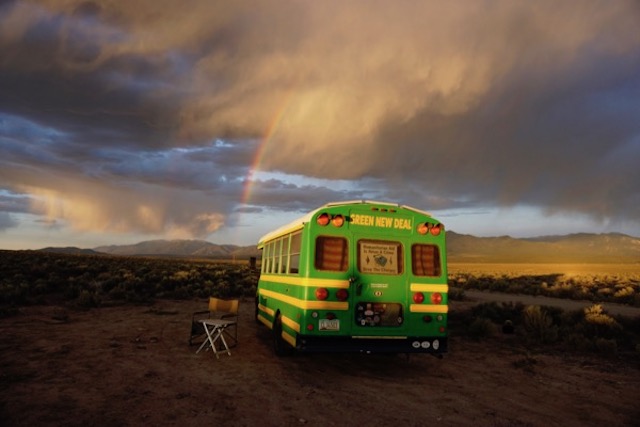Proud To Be “Cancelled” By NJ Environmental Leaders
They Are Political Whores Who Are Incapable Of Substantive Argument
You’re all just pissin’ in the wind
You don’t know it but you are
And there ain’t nothin’ like a friend
Who can tell you you’re just pissin’ in the wind. ~~~ Ambulance Blues, Neil Young (1974)

Dave Pringle led the EJ bill campaign. Folks should know that after endorsing Chris Christie for Gov. in 2009, Dave Pringle provided cover for DEP for 2 years. Here he is sucking up with Christie DEP Commissioner Bob Martin.
It’s not unusual in the NJ environmental community to have good faith disagreements about interpretations of complex environmental laws, or different views about policy issues like what to emphasize, strategic judgments of what’s politically feasible, or on the tactics how to frame an issue or a message.
But it is unusual for there to be disputes about basic facts and for those disputes to be grounded in bad faith – e.g. knowing, intentional and self serving factual lies and highly misleading public statements – and for these lies and spin to be printed as fact by the media.
I have not seen this degree of bad faith lying on Gov. Murphy’s EJ law since the NJ Green Mafia lied to and intentionally misled the public about the Constitutional amendment that diverted environmental funds to support the Open Space program.
I recently called out these lies and misinformation in an email broadcast to everyone in my email library. I provided a link to my detailed analysis (see this) and wrote that “anyone who unconditionally supported this [EJ] bill should be ashamed of themselves” –a criticism I stand by.
But instead of substantively engaging my arguments, most NJ ENGO’s put their heads in the sand and lined up to “cancel” me for perceived “insults” – just like the Trump cultists. I’m referring to Dave Pringle, Maya Van Rossum, and Patty Cronheim.
In response, a friend wrote:
Bill,
I too find it incredible that these people want off a list that would possibly provide an educational debate with people who agree with David and those with you.
How can “thoughtful” people be critical of trump’s mindless base that unquestionably agree with their Fuhrer if they close off their minds to a discussion on this environmental law? Beats the hell out of me.
So, since I am making such harsh claims, let me be specific and back those claims up.
There are flat out knowingly false statements (which I will call lies), as well as lies by omission. There also are intentionally misleading statements that go far beyond the typical spin and are designed to dupe the public.
1. NJ Spotlight has published 3 stories that falsely claim that local governments have been granted “power” to block projects
This is NJ Spotlight’s most recent and third lie on this issue:
Prior versions of the EJ bill included a provision that authorized a local veto.
For example, Section 3.c. of S1700 (the bill from the 2018 legislative session) provides:
The department shall not approve a permit application for a project in a burdened community unless the governing body of the municipality in which the burdened community is located adopts an ordinance approving the project.
But that local veto provision was stripped and is NOT in the bill the Gov. signed into law. Period. No debate, that is a fact.
I’ve contacted NJ Spotlight editor John Mooney – twice – asking for corrections and an opportunity to set the facts straight in an op-ed, but received no response. Here are more facts, with links prove that:
Why does NJ Spotlight continue to mislead readers about this crucial issue? Three times no less?
Why have no EJ advocates corrected the egregious Spotlight falsehood?
Why do they attack me for pointing it out?
2. Nationally renowned NJ based environmental scientist and activist Peter Montague falsely wrote (in a national publication) that the EJ bill provided a legal “right” to a “clean environment”
Peter Montague – who I met in the 1980’s as a DEP analyst during public battles to stop garbage incinerators, especially sited in black neighborhoods – wrote an “analysis” piece for Truthout, which was published the day before Gov. Murphy signed the EJ bill into law (thus was a coordinated set up piece), see:
The headline is false – the EJ law provides no such legal “right”. In fact, it ignores and does not amend NJ Civil Rights law and ignores federal civil rights law, including on point EJ case law made here in a Camden NJ case. The headline error is repeated in the text of the article.
Montague’s article is not only factually false about the legal “right”, it is highly misleading on several other issues
An actual NJ EJ case out of Camden NJ has set a huge legal precedent in Civil Rights law with respect to proving “disproportionate burden” see: South Camden Citizens v. NJ Dept. of Environ., 145 F. Supp. 2d 446 (D.N.J. 2001)
Camden EJ activists won a US District Court case that basically ruled that factual evidence of disparate impact was sufficient to demonstrate a civil rights violation under federal law. The District Court Judge issued a scathing opinion, denouncing DEP’s failure to address EJ issues in the permit program. I’ve written on that opinion numerous times. Most recently, for details, including excerpts from the decision and links, see:
But that District Court decision was reversed on legal grounds by the Circuit Court of Appeals (the District Court’s factual findings still stand), who set a very high burden of proof which requires demonstration of a conscious intent to discriminate, not just disparate or disproportionate impact. Read this and weep:
The EJ law not only failed to include a legal “right” as Montague claims, but it ignored all these controversial and highly relevant civil rights issues.
Montague also made misleading statements, like this:
“Children are especially vulnerable to the adverse health effects caused by pollution, and such health effects may severely limit a child’s potential for future success,” the law says.
The EJ “law’ does in fact say that, but it says it in the “Legislative Findings” not the black letter law. Legislative findings do not have the force and effect of law, they are essentially window dressing. Montague falsely clams that this language is law, when it is not.
Specifically, the law does not revise the scientific methods or regulatory standards by which DEP conducts risk assessment with respect to children’s health or developmental effects.
When a long time activist apparently doesn’t know the difference between legislative findings (which are unenforceable window dressing) and substantive enforceable black letter law, then we have either a competence problem or an honesty problem.
Same thing with the failure to understand civil rights law and what an enforceable legal “right” is, versus what thin gruel the EJ bill provides. (I’m certain that Montague is aware of the Camden District and Circuit Court decisions).
Montague made similarly misleading claims by citing the definition of “environmental or public health stressors” . While that definition is broad, it is severely limited by the law, which only applies to DEP permits and is further limited by the law’s limited scope of “cumulative impact”, which excludes small sources or air pollution below 100 tons per year.
For example, “mobile sources” of pollution are included in that definition, but DEP does not regulate and issue permits to mobile sources.
Montague plays the same misleading game when it comes to “cumulative impacts”, where he writes:
The term for such an evaluation is a “cumulative impacts assessment” of a facility. The federal Council on Environmental Quality issued guidancefor “cumulative impacts assessment” in 1997, and the federal Environmental Protection Agency issued related guidance in 2003. The NJ DEP’s Environmental Justice Advisory Council issued its own “Strategies for Addressing Cumulative Impacts in Environmental Justice Communities” in 2009. (Disclosure: I served as an advisor for that report.)
But the actual text of the law does not include or even refer to the CEQ Guidance, the EPA Guidance or the NJ EJA Report he cites.
Contrary to what Montague claims, there are no scientific methods or standards in the law and the law does NOTHING to change the currently seriously flawed scientific and regulatory methods DEP relies on to issue permits. For a detailed explanation of that, see:
For a discussion on how the EJ law fails to address currently flawed DEP science and permit regulations, see:
There are several other misleading claims and lies by omission.
These are basic and unforgivable misinformation tactics by Montague.
Why would Maya Van Rossum, who is leading a campaign to seek a Constitutional Amendment to establish such a legal right, not have a big problem with this and instead attack me personally for exposing this damaging false claim?
3. The group Rethink NJ misleadingly wrote that DEP is “required to consider the cumulative impacts of fossil fuel” projects
Rethink NJ – the sycophants FERC-ing off the PennEast pipeline fight while ignoring the Section 401 WQC kill – broadcast an email praising the Gov and in support of the law with the following highly misleading claim (emphasis mine):
Governor Murphy just signed one of the nation’s strongest environmental justice bills into law. Under the law, the NJ Department of Environmental Protection will be required to consider the cumulative impacts of fossil fuel and other polluting projects on overburdened communities when considering permits for such projects.
I don’t know if it’s one of the nation’s strongest laws, but that statement with respect to “fossil fuel” projects is HIGHLY misleading if not downright false by omission.
Specifically, the EJ law does not apply to or authorize DEP to regulate greenhouse gas emissions. Current DEP regulations do not regulate greenhouse gas emissions.
The law does not authorize DEP to regulate or issue permits based on climate impacts, like urban heat island effects that are literally killing people living in EJ communities (i.e. adaptation).
The law does not authorize DEP to require energy conservation, energy efficiency, renewable energy, or any offsets or mitigation that might results from a facility’s lifecycle carbon footprint.
It is disgustingly misleading – basically a lie – for Rethink NJ to claim or imply that DEP EJ reviews on “fossil fuel” projects will address climate justice. For an egregious example of that, see:
4. EJ Activists praised the law in Gov. Murphy’s press release, despite the fact that the bill fails to address their concerns
See this post for a detailed discussion about how and why the law will not address the specific problems that an experienced EJ activist faced.
5. Lies by Omission – DEP “compelling public interest” Waiver
Back in 2012, the Christie DEP adopted a “waiver rule” which provided authority to DEP to waive certain regulations under certain narrow conditions.
The NJ ENGO community went totally ballistic and mounted a coordinated statewide campaign opposing the rule and blasting the Christie DEP for proposing and then adopting it.
The Christie DEP waiver rule was regulatory, not legislative, making it far legally weaker than legislation and much easier to reverse by a subsequent administration. [We note that the Murphy administration has not repealed the Christie DEP waiver rule.] The waiver rule also came with very specific restrictions in scope and with very specific conditions designed to limit abuse, protect the environment, and make any waivers transparent and subject to public comment.
Importantly, the Christie DEP waiver rule could not over-ride a DEP scientific finding or regulatory determination. DEP was prohibited from finding that a waiver request violated a DEP regulation and issue a waiver anyway, based on a competing economic or political interest. A DEP waiver could not contradict a core regulatory protection objective.
In contrast, the EJ law provides DEP the authority to waive core scientific findings and regulatory determinations that the permit application legally must be denied. DEP may waive the core objective of the law, which is a mandate that DEP deny a permit to a new facility that would cause or contribute to an unjust disproportionate burden .
Let me explain.
Under the EJ law, DEP is required to deny a permit (“shall deny”) for a new facility that: (Section 4.c.)
would, together with other environmental or public health stressors affecting the overburdened community, cause or contribute to adverse cumulative environmental or public health stressors in the overburdened community that are higher than those borne by other communities within the State, county, or other geographic unit of analysis as determined by the department pursuant to rule, regulation, or guidance
But there is a HUGE loophole in the law.
The same section 4.c. provides an “exception” to the requirement that a permit be denied.
DEP is authorized to waive the permit denial mandate when a facility would “serve a compelling public interest”:
except that where the department determines that a new facility will serve a compelling public interest in the community where it is to be located, the department may grant a permit that imposes conditions on the construction and operation of the facility to protect public health.
Environmentalists have long opposed efforts to insert “compelling public interest” loopholes in environmental laws and regulations.
When they have lost those debates, the concept of compelling public need has been severely narrowed in scope and subject to detailed protective conditions. For example, the Highlands Act provides a loophole, but it is limited, restricted in scope, and must be publicly demonstrated and based on science, e.g.:
except in the case of a demonstrated need to protect public health and safety
DEP still must protect “public health”, but there is no such “public health” demonstration limiting the EJ law’s loophole, which can be based on economics, politics, or any other factor a creative lawyer can imagine.
[Full disclosure: I was involved in drafting the Highlands Act.]
Note how much more damaging this EJ “waiver” is than the Christie DEP waiver rule.
It is in statute and would take new legislation to reverse. There is no definition of “compelling public need” a very broad concept. That concept may specifically over-ride a DEP scientific finding and regulatory determination. There are no technical conditions to limit the scope and applicability. There is no transparency. There is no public involvement.
The EJ law provides a legal basis for corporate polluters to over-ride DEP science on very broad, virtually unlimited grounds (for example, the chemical industry claims that there is a “compelling public need” to manufacture chemicals involved in Kevlar vests that protect US troops and militarized cops).
Yet not one peep of criticism about this waiver by the EJ and ENGO advocates – not one peep – despite the fact that is guts their bill and their outrage over a far less damaging waiver by the Christie DEP.
I rest my case.
But there are more flaws and ENGO/EJ community lies and spin that follow a similar pattern
6. Lies by Omission – Cumulative Impact Standard Gutted By 100 TPY Pollution Threshold
The law creates a 100 ton per year air pollution threshold.
Pollution sources less than 100 tons per year are not regulated.
This defeats the basic concept of cumulative impacts, because the whole point is based on the fact that many small sources are the problem. But the EJ law exempts many small sources. DEP’s own prior research on hazardous air pollution and EJ in Paterson NJ demonstrates this fact.
The law is silent about how the cumulative air pollution from unregulated small sources is to be considered.
Yes the cheerleaders signed off on this “compromise” which guts the core concept of the law.
7. Crickets from press corps on toxic cleanup loophole, even from those who wrote “Dirty Little Secrets” series
WNYC and various NJ media outlets (which include the Bergen Record and NJ Spotlight who have written very favorable stories about this law) recently published an investigative journalism series titled: “Dirty Little Secrets”.
This installment in that series is especially relevant to the EJ law:
For 150 years, New Jersey manufactured chemicals and products that became familiar fixtures in homes: charcoal and lighter fluid, plastic, guns and silk. It’s the job of the state’s Department of Environmental Protection to ensure that New Jersey’s industrial past isn’t affecting the health of residents today.
But an investigation by WNYC finds most of the state’s poorest residents are living near a contaminated site with no plan in place to clean it up. And it’s not entirely clear whether anybody even knows with certainty what the risks are.
The health of NJ’s poorest will continue to be put at risk, they will continue to not know the risks, and there is no plan to reduce those risks, all because the EJ law explicitly exempts toxic site cleanups.
First of all, it does not apply to over 100 federal Superfund sites and several thousands federal RCRA toxic sites, many of which are worse than Superfund sites (e.g. Dupont Pompton Lakes).
Second, it exempts NJ DEP site cleanups conducted under NJ state law, see the definition of “permit” on page 3:
except that “permit” shall not include any authorization or approval necessary to perform a remediation, as defined pursuant to section 23 of P.L.1993, c.139 (C.58:10B-1
Now, why aren’t those news outlets who were so concerned about NJ’s poorest being exposed to toxic site risks not criticizing this law for this egregious unjust loophole, and instead praising the law?
Ironically, the NJ toxic site cleanup “Site Remediation Reform Act” law – that privatized the cleanup program – was the first law to actually address EJ, way back in 2009, with this provision, which DEP has failed to enforce for 11 years
b. The department shall perform additional review of any document, or shall review the performance of a remediation, if:
[(1) – (2)]
(3) the contaminated site is located in a low-income community of color that has a higher density of contaminated sites and permitted discharges with the potential for increased health and environmental impacts, as compared to other communities; (Section 21, Site Remediation Reform Act)
So, not only is the EJ law seriously flawed, it was not even the first NJ law to apply to EJ and disproportionate and disparate impacts.
DEP has failed to enforce the 2009 law with respect to EJ, so what makes anyone think they would aggressively enforce a far broader law, using the same regulatory tools?
That failed 2009 law was exposed by the media’s “Dirty Little Secrets” series, and NJ reporters and the EJ cheerleaders – that’s you Anna Baptista, who was quoted in the above story – know all about it.
Yet why not one word of criticism about this egregious loophole? Instead we hear cheerleading for a “groundbreaking law” and “national; model”.
Like I said, “shame on them”.
[End Note: I want to particularly target Dave Pringle in this post, for 2 reasons: 1) he was probably the lead lobbyist on the bill; and 2) after refusing to engage any of my criticism, he basically called me a racist by writing this:
Finally, a shout out to all on this list (not created by me, and a very interesting mix I might add, although very white in contrast to the group that was lead in passing the bill) that helped get this bill done.
Dave is the one who squandered the political opportunity created by the BLM movement. He is the one who sold out and compromised the black community. I had nothing to do with any of that.
I’ve written about and criticized many of the Newark EJ advocates Dave works with; Amy Goldsmith, Kim Gaddy, Anna Baptista, and ICC as basically incompetent and corrupt machine tools.
I’ve linked to the work of others who criticize Booker and the Essex County and Newark politicians as perfect examples of what Glen Ford calls “the Black Misleadership Class”.
I’ve noted my prior work with South Jersey EJA, including Roy Jones and Olga Palmar. I really don’t need to establish any policy chops or street credibility on these issues.
With respect to the complex issues of race and class, although I am a strong support of BLM, I come down on the side of Adolph Reed, who critiques the effects and implications of identity politics in favor of more universal class based appeals.
I’ve written extensively about all this for many years.
I’ve never heard or read anything from Dave Pringle on any of this. It’s all intellectually over his head. Dave is a lightweight, with little credibility, except among the misguided ones he works with that look to him for leadership.
To avoid exposing all that, Dave plays the race card and calls me a racist. What a fucking little scumbag.






